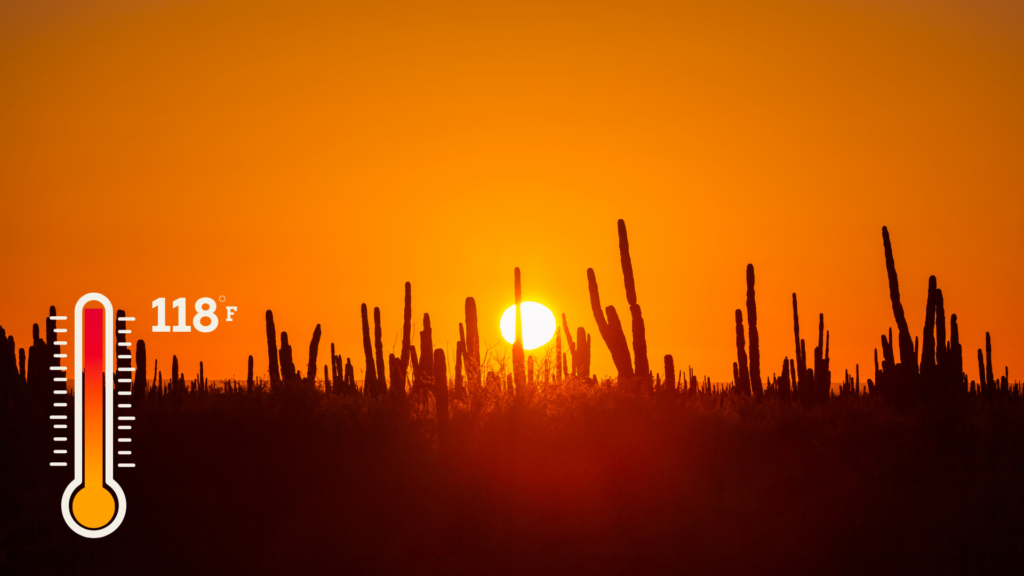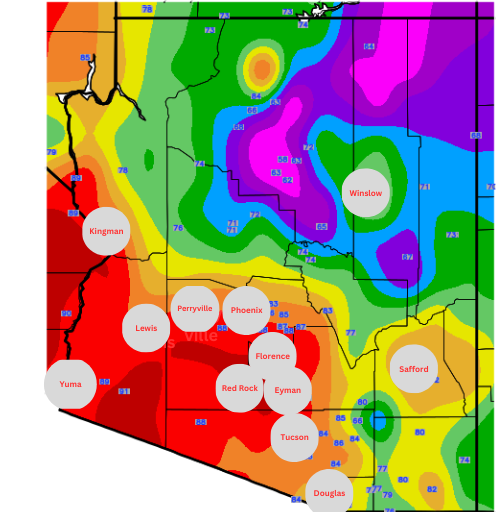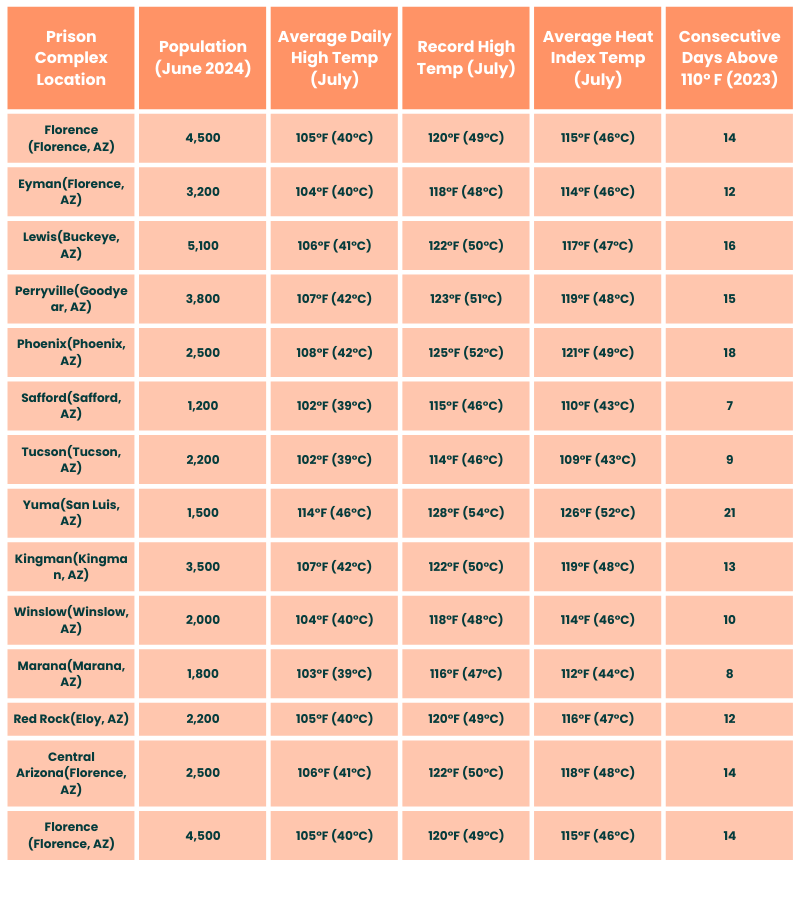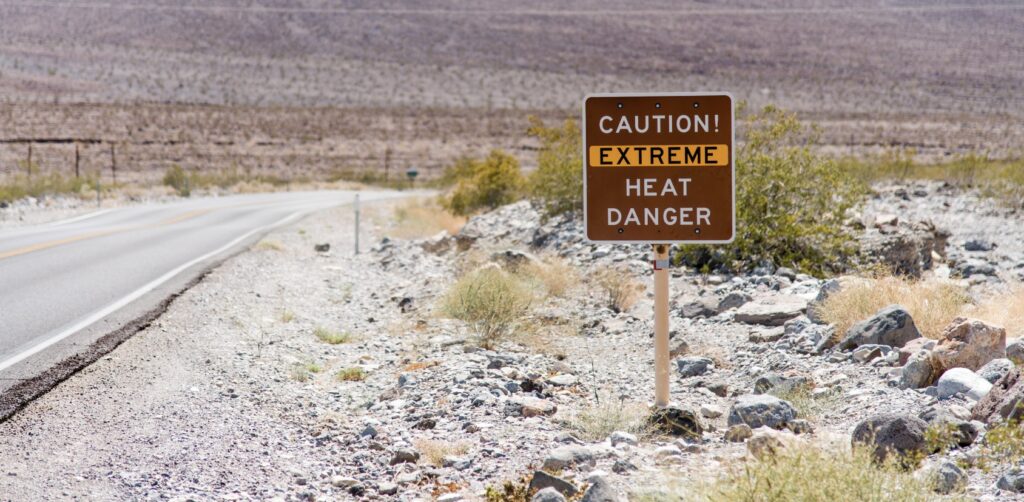Extreme Heat in Prisons: Arizona’s Unrelenting Summers

Authored by Dream.Org
In the scorching Sonoran Desert of Arizona – where summer temperatures routinely soar above 110° F – the Arizona Department of Corrections oversees a sprawling prison system that spans 10 complexes throughout the state. In addition, the state of Arizona contracts with Geo Group and Core Civic to house incarcerated people at seven private prison facilities. Each complex comprises at least one housing unit, with most featuring multiple units of varying security classification levels.
Currently, the ADCRR has approximately 39,400 individuals under its custody, with around 35,000 in the department and the remainder on community supervision. Despite being the 14th most populous state in the country, Arizona has the dubious distinction of having the fifth-largest per-capita prison population in the world, with a peak population of 42,400 people in 2019.
Within this expansive system, a humanitarian crisis is unfolding in the scorching Sonoran Desert of Arizona, where summer temperatures routinely soar above 110°F (38°C). Incarcerated individuals are subjected to brutal conditions, with many facilities lacking adequate air conditioning and proper heat mitigation measures. This blog post delves into the dire situation faced by those imprisoned in Arizona, focusing on the extreme heat, its impact on health, and the urgent need for reform.
The Dangers Are Real - So Is the Apathy
The dangers of extreme heat in Arizona's prisons were brought to light in 2009 with the tragic death of Marcia Powell, a 48-year-old woman serving a 27-month sentence for solicitation of prostitution at Perryville Prison.
On May 20, 2009, Powell was left in an uncovered outdoor cage for nearly four hours in temperatures exceeding 107°F (41.7°C). Despite her pleas for water and help, correctional officers ignored her and mocked her requests. Powell eventually collapsed from the heat and was found unconscious, in grave condition. She was transported to a nearby hospital, where she was diagnosed with heat stroke and brain damage. Her core body temperature upon examination was 108°F (42.2°C).
Powell died later that day after being taken off life support by prison officials without notifying her court-appointed guardian. An investigation revealed that correctional officers had denied Powell water and ridiculed her when she pleaded for help. However, no one was held accountable for her death.
The incident exposed the inhumane conditions and practices within Arizona's prison system, particularly the use of outdoor cages and the lack of adequate protection from extreme temperatures.
The Sonoran Desert: A Furnace for Arizona Prisons
Arizona's prisons are predominantly located in the Sonoran Desert, known for its unrelenting heat. While many assume Arizona experiences only dry heat, the state has a monsoon season that brings increased humidity, exacerbating the already oppressive conditions. The combination of high temperatures and humidity creates a dangerous heat index, making it feel even hotter than the thermometer reads.

Image of the state of Arizona with temperature zones showing the location of the Arizona state prison facilities.
Incarcerated individuals in Arizona are often housed in older facilities that were not built with air conditioning. These structures, made of concrete and steel, trap heat inside, turning them into virtual ovens. The lack of adequate cooling poses severe health risks, particularly for those with pre-existing medical conditions or taking certain medications.
Forced Labor in Extreme Conditions
Adding to the inhumane conditions, incarcerated individuals in Arizona are required to perform labor outdoors, often in direct sunlight, without proper protective gear. The Arizona Department of Corrections does not have a universal policy mandating the provision of appropriate clothing, such as wide-brimmed hats and long-sleeved shirts, to mitigate sun exposure. Consequently, many individuals suffer heat exhaustion or stroke, sun sickness, and develop skin conditions such as carcinoma and melanoma, due to prolonged exposure to the sun's harmful rays.
Incarcerated individuals are assigned to work details that range from maintaining prison grounds and facilities to working in agriculture, construction, and other industries. These work assignments often involve strenuous physical labor, which can be particularly dangerous in the oppressive heat. Individuals are expected to work for hours on end, with limited access to shade, water, and rest breaks. The lack of proper hydration and the inability to cool down adequately can lead to severe dehydration, heat exhaustion, and even heat stroke.
Moreover, the extreme heat can exacerbate pre-existing health conditions, making it even more challenging for incarcerated individuals to perform their assigned tasks safely. Those with respiratory issues, cardiovascular problems, or other chronic illnesses are particularly vulnerable to the effects of extreme temperatures. The combination of forced labor and inadequate heat mitigation measures creates a dangerous and potentially life-threatening situation for those who are already in a vulnerable position.
The Heat Index: How It Really Feels
While the air temperature alone paints a grim picture, it fails to capture the true extent of the heat inside Arizona's prisons. The heat index, which takes into account both temperature and humidity, provides a more accurate representation of how hot it feels. In concrete and steel buildings that lack air conditioning, the heat index can reach dangerous levels, putting the health and well-being of both incarcerated individuals and staff at risk.

Please note that the incarcerated population figures are subject to change and may not reflect the current population. The weather data is based on historical averages and may vary from year to year. The consecutive days above 110°F are based on summer 2023 weather records.
The Impact on Correctional Staff
It is important to acknowledge that the extreme heat in Arizona prisons also affects the correctional staff. These individuals, who work on the front lines, are often required to wear full uniforms, including long sleeves, pants, and heavy boots, as well as protective gear such as stab vests and duty belts. This attire, while necessary for safety and security, significantly intensifies the impact of the oppressive heat.
Correctional officers spend long hours patrolling the grounds, supervising work details, and performing other duties that frequently take them outdoors or into non-air-conditioned areas. The combination of physical exertion and exposure to extreme temperatures puts them at risk of heat-related illnesses, such as heat exhaustion and heat stroke. Moreover, the constant discomfort and fatigue caused by working in such conditions can lead to decreased alertness, impaired judgment, and a heightened potential for errors or accidents.

In addition to the physical toll, the harsh conditions also take a mental and emotional toll on correctional staff. The intense heat contributes to increased irritability, short tempers, and a general sense of frustration among both staff and incarcerated individuals. This heightened tension can escalate into confrontations, making an already stressful work environment even more challenging and potentially dangerous.
Correctional staff, like incarcerated individuals, deserve a safe and humane work environment. Subjecting them to extreme heat not only jeopardizes their well-being but also compromises the safety and security of the entire prison system. Addressing the issue of extreme temperatures is crucial not only for the health and dignity of those who are incarcerated but also for the men and women who work tirelessly to maintain order and ensure the smooth operation of Arizona's prisons.
Falsified Temperature Logs
The local NBC news affiliate in Phoenix, 12News, submitted a large public records request to the ADCRR for records of temperature logs completed by correctional staff at a number of the housing units in Arizona. What they found led to allegations of correctional officers falsifying temperature logs to downplay the severity of the heat inside Arizona's prisons.
The Channel 12 story was a follow-up to a 2017 Phoenix New Times piece where it was reported that the Arizona Department of Corrections (ADC) had been providing misleading temperature data to the court as part of a lawsuit settlement. The settlement required the ADC to monitor and record indoor temperatures in state prisons.
However, an investigation revealed that some correctional officers at Perryville Prison had filled out temperature logs days in advance, recording temperatures significantly lower than those reported elsewhere in the state during the same period. Furthermore, the 12News I-Team obtained temperature logs from Perryville Prison in 2023, which showed that certain cells had reached temperatures of over 100°F (37.8°C) on July 17.
This discovery further highlighted the ongoing issues with extreme heat in Arizona's prisons and the lack of transparency from prison officials.
A Plan for Change: Retrofitting Arizona's Prisons
In response to the growing concern over the extreme heat in its prisons, the ADCRR has published a schedule to retrofit or install air conditioning in its facilities over the next two years. However, given the department's history of delays and inadequate execution of plans, there is skepticism about the timely and effective implementation of these upgrades.
The extreme heat in Arizona prisons is a humanitarian crisis that demands immediate attention and action. The inhumane conditions endured by incarcerated individuals, coupled with the lack of adequate heat mitigation measures, constitute a grave violation of human rights. It is imperative that the Arizona Department of Corrections, Rehabilitation, and Reentry follows through on its promised reforms by taking swift action to install proper air conditioning and implementing policies that protect the health and well-being of both incarcerated individuals and correctional staff.
As a society, we must recognize that subjecting individuals to such brutal conditions is unacceptable, regardless of their criminal history. The humane treatment of all individuals, including those who are incarcerated, is a fundamental principle that must be upheld. Furthermore, we must acknowledge the immense strain placed on correctional staff who work in these oppressive conditions and advocate for their well-being and safety.
It is time for Arizona to address this crisis head-on and demonstrate a commitment to ensuring that its prison system respects the basic human rights and dignity of all those within its walls, both those who are incarcerated and those who work to maintain order and security. Only by confronting this issue with urgency and compassion can we hope to create a more just and humane system that truly serves the interests of all involved.
Sign the petition and tell Congress to pass federal legislation establishing nationwide standards for temperature control in correctional facilities.
